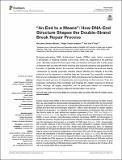Por favor, use este identificador para citar o enlazar a este item:
http://hdl.handle.net/10261/221222COMPARTIR / EXPORTAR:
 SHARE SHARE
 CORE
BASE CORE
BASE
|
|
| Visualizar otros formatos: MARC | Dublin Core | RDF | ORE | MODS | METS | DIDL | DATACITE | |

| Campo DC | Valor | Lengua/Idioma |
|---|---|---|
| dc.contributor.author | Serrano-Benítez, Almudena | es_ES |
| dc.contributor.author | Cortés-Ledesma, Felipe | es_ES |
| dc.contributor.author | Ruiz, José F. | es_ES |
| dc.date.accessioned | 2020-10-15T08:56:42Z | - |
| dc.date.available | 2020-10-15T08:56:42Z | - |
| dc.date.issued | 2020 | - |
| dc.identifier.citation | Frontiers in Molecular Bioscience 6: 153 (2020) | es_ES |
| dc.identifier.uri | http://hdl.handle.net/10261/221222 | - |
| dc.description.abstract | Endogenously-arising DNA double-strand breaks (DSBs) rarely harbor canonical 5′-phosphate, 3′-hydroxyl moieties at the ends, which are, regardless of the pathway used, ultimately required for their repair. Cells are therefore endowed with a wide variety of enzymes that can deal with these chemical and structural variations and guarantee the formation of ligatable termini. An important distinction is whether the ends are directly “unblocked” by specific enzymatic activities without affecting the integrity of the DNA molecule and its sequence, or whether they are “processed” by unspecific nucleases that remove nucleotides from the termini. DNA end structure and configuration, therefore, shape the repair process, its requirements, and, importantly, its final outcome. Thus, the molecular mechanisms that coordinate and integrate the cellular response to blocked DSBs, although still largely unexplored, can be particularly relevant for maintaining genome integrity and avoiding malignant transformation and cancer. | es_ES |
| dc.description.sponsorship | Work in the FC-L laboratory was funded with grants from the Spanish and Andalusian Government (SAF2017-89619-R, CVI-7948, European Regional Development Fund), and the European Research Council (ERC-CoG-2014-647359); and with an individual fellowship for AS-B (Beca Predoctoral AEFAT, Asociación Española Familia Ataxia Telangiectasia). CABIMER was supported by the Andalusian Government. | es_ES |
| dc.language.iso | eng | es_ES |
| dc.publisher | Frontiers Media | es_ES |
| dc.relation | info:eu-repo/grantAgreement/EC/H2020/647359 | es_ES |
| dc.relation | info:eu-repo/grantAgreement/AEI/Plan Estatal de Investigación Científica y Técnica y de Innovación 2017-2020/SAF2017-89619-R | es_ES |
| dc.relation | SAF2017-89619-R/AEI/10.13039/501100011033 | es_ES |
| dc.relation.isversionof | Publisher's version | es_ES |
| dc.rights | openAccess | es_ES |
| dc.title | “An end to a means”: How DNA-end structure shapes the double-strand break repair process | es_ES |
| dc.type | artículo | es_ES |
| dc.identifier.doi | 10.3389/fmolb.2019.00153 | - |
| dc.description.peerreviewed | Peer reviewed | es_ES |
| dc.relation.publisherversion | https://doi.org/10.3389/fmolb.2019.00153 | es_ES |
| dc.identifier.e-issn | 2296-889X | - |
| dc.rights.license | http://creativecommons.org/licenses/by/4.0/ | es_ES |
| dc.contributor.funder | Junta de Andalucía | es_ES |
| dc.contributor.funder | Agencia Estatal de Investigación (España) | es_ES |
| dc.contributor.funder | Ministerio de Ciencia, Innovación y Universidades (España) | es_ES |
| dc.contributor.funder | European Research Council | es_ES |
| dc.contributor.funder | European Commission | es_ES |
| dc.contributor.funder | Asociación Española Familia Ataxia Telangiectasia | es_ES |
| dc.relation.csic | Sí | es_ES |
| oprm.item.hasRevision | no ko 0 false | * |
| dc.identifier.funder | http://dx.doi.org/10.13039/501100000780 | es_ES |
| dc.identifier.funder | http://dx.doi.org/10.13039/501100000781 | es_ES |
| dc.identifier.funder | http://dx.doi.org/10.13039/501100011033 | es_ES |
| dc.identifier.funder | http://dx.doi.org/10.13039/501100011011 | es_ES |
| dc.identifier.pmid | 31998749 | - |
| dc.type.coar | http://purl.org/coar/resource_type/c_6501 | es_ES |
| item.openairetype | artículo | - |
| item.grantfulltext | open | - |
| item.cerifentitytype | Publications | - |
| item.openairecristype | http://purl.org/coar/resource_type/c_18cf | - |
| item.fulltext | With Fulltext | - |
| item.languageiso639-1 | en | - |
| Aparece en las colecciones: | (CABIMER) Artículos | |
Ficheros en este ítem:
| Fichero | Descripción | Tamaño | Formato | |
|---|---|---|---|---|
| andendproce.pdf | 650,88 kB | Adobe PDF |  Visualizar/Abrir |
CORE Recommender
PubMed Central
Citations
7
checked on 14-abr-2024
SCOPUSTM
Citations
10
checked on 21-abr-2024
WEB OF SCIENCETM
Citations
10
checked on 29-feb-2024
Page view(s)
125
checked on 23-abr-2024
Download(s)
167
checked on 23-abr-2024

